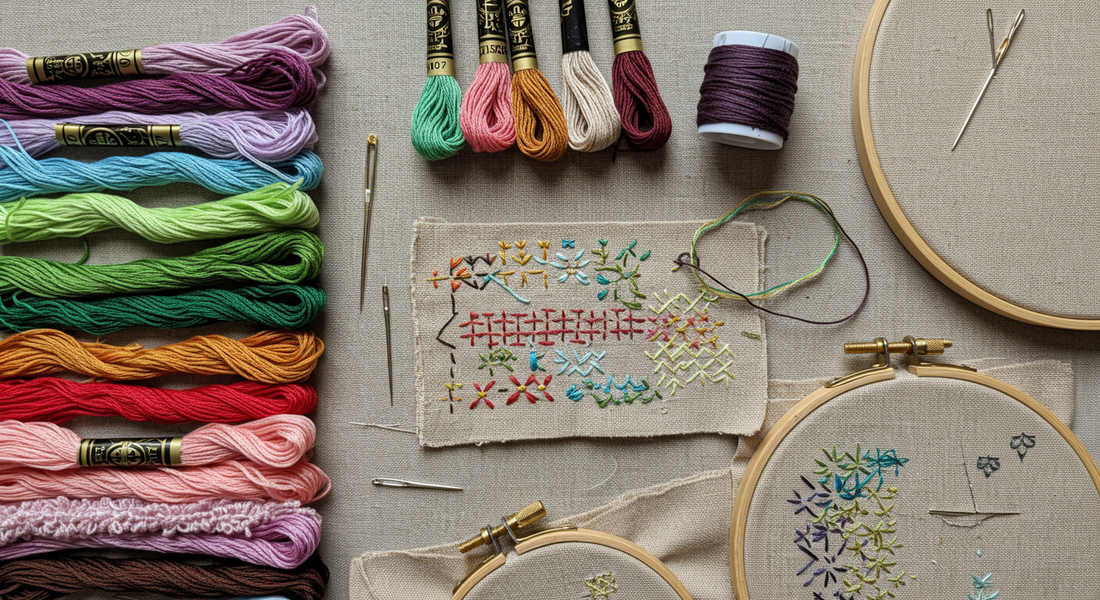
Using Specialty Threads by Hand
Share
Mastering Metallics, Variegated Floss, Glow-in-the-Dark Threads, and More
Specialty threads can elevate hand embroidery from beautiful to breathtaking. Whether you're adding sparkle with metallics, rich color gradients with variegated floss, or magical glow effects, these threads offer texture, light, and movement that ordinary cotton can't match. But they also come with quirks—like tangling, fraying, and tension challenges.
In this in-depth guide, we’ll explore how to choose, stitch with, and care for a variety of specialty threads to enhance your embroidery with confidence.

1. Types of Specialty Threads
Metallic Threads
- Often made with synthetic core wrapped in metal foil
- Available in soft or stiff textures
- Provide shine and reflective highlights
Variegated Threads
- Gradual color shifts along the thread
- Excellent for organic effects like florals, waves, or sky
Glow-in-the-Dark Threads
- Charged by light and glow in darkness
- Fun for kids' designs, costume work, or secret messages
Silk & Rayon Threads
- High sheen and soft drape
- Luxurious finish, but slippery to handle
Textured or Novelty Threads
- Fuzzy, looped, or fluffy textures
- Ideal for adding fur, foliage, or raised effects

2. Challenges and Solutions
Tangling & Knotting
- Cut shorter lengths (12–15 inches max)
- Let thread dangle every few stitches to unwind naturally
- Use a thread conditioner (like Thread Heaven or beeswax)
Fraying at the Eye
- Use a needle with a larger eye to reduce friction
- Avoid pulling through tightly woven fabric too many times
- Consider doubling the thread through the needle for extra control
Stitch Tension
- Loosen your tension slightly for bulky or rigid threads
- Avoid pulling too tight—let the thread sit on the surface
Needle Choice
- Use a tapestry needle or crewel needle with rounded eye
- For fuzzy threads, consider a chenille needle
3. Stitch Selection for Best Effect
Certain stitches bring out the qualities of specialty threads better than others:
For Metallics:
- Couching (lay thread on surface and tack it down)
- Stem stitch or backstitch for clean lines
For Variegated Threads:
- Long and short stitch (to showcase gradients)
- Chain or feather stitch (adds visual motion)
For Textured Threads:
- French knots, colonial knots, turkey work (perfect for depth)

4. Blending with Other Threads
Specialty threads are even more impactful when combined with standard cotton floss:
- Use metallic threads to outline or highlight cotton shapes
- Mix variegated with solids for shading effects
- Combine silk and wool threads for contrast in sheen and softness
Layering or couching different thread types can create rich visual and tactile effects.
5. Care & Storage
- Store specialty threads in separate compartments or zip bags to avoid tangling
- Avoid moisture and humidity (especially with metallics)
- Always wash embroidered items gently by hand in cold water
- Air dry and iron from the reverse side with a pressing cloth

Bonus Tip: Try a Sample Stitch Card
Create a mini sampler of specialty threads on a fabric scrap. This helps you:
- Practice stitch technique
- Test needle compatibility
- See how each thread behaves on fabric
Keep this sampler as a reference for future projects.
Final Thoughts
While specialty threads may seem intimidating at first, a few adjustments to your stitching habits make them approachable—and powerful. From shimmering highlights to dramatic textures, they give you tools to transform simple embroidery into a multi-sensory experience. Embrace the challenge, experiment boldly, and let your stitches shine.